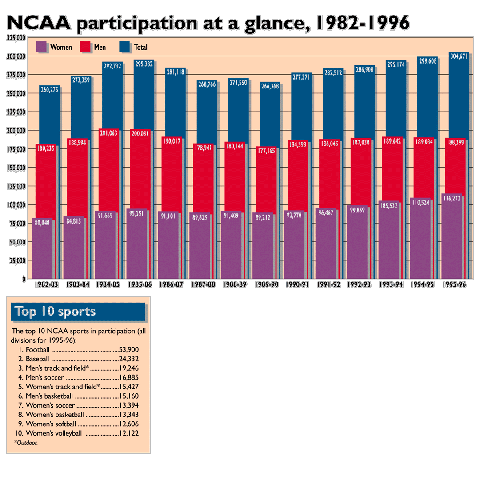
National Collegiate Athletic Association |
The NCAA News DigestMarch 30, 1998
How many student-athletes compete in varsity intercollegiate sports at NCAA member institutions? The most recent estimate, made for the 1995-96 academic year, showed that 304,671 student-athletes competed at the 902 active member institutions in all three divisions. Counting provisional members, the total is 323,388. Most participants are found in Division I, where almost 135,000 compete. Division II has about 68,000 participants, while Division III offers opportunities to slightly more than 120,000 student-athletes. Football has the most participants of any sport in all three divisions -- more than twice as many overall as second-place baseball. More student-athletes compete in track and field than any other women's sport, with soccer, basketball and softball not far behind. Men's participation has been static over the last decade while women's participation has increased almost 28 percent.
RESEARCHMajor study provides insight into basketball An NCAA-commissioned survey on college basketball reveals that there are more than 68 million fans of the men's game and more than 44 million fans of women's basketball. The study by Taylor Research & Consulting Group, Inc., was commissioned by the NCAA in November 1997. It was designed to examine a range of issues related to the state of college basketball, with an equal focus on both the men's and the women's games. Preliminary results show that both men's and women's basketball are highly regarded by the public but that some concerns exist about both sports. Among those concerns are that the men's game has become too commercial and that the women's game has a limited appeal. The purpose of the study is to provide the NCAA with information that will help guide college basketball's marketing efforts for the foreseeable future. Staff contact: C. Dennis Cryder.
LITIGATIONFederal appeals court rules that Title IX applies to NCAA A U.S. appeals court has ruled that Title IX applies directly to the NCAA because the As-sociation receives dues money from institutions that receive federal aid. The case itself deals with the denial of a waiver for a student-athlete who sought relief from a bylaw relating to eligibility for postgraduate students. The plaintiff, Renee M. Smith, sued, claiming that waivers to the bylaw were granted more often to men than to women, thus violating Title IX. The case was never tried on its merits because a district court ruled that the plaintiff had never demonstrated that the NCAA receives federal funds and that the Association therefore could not be sued under Title IX. However, the appeals court held that the NCAA may be sued under Title IX because it receives dues from institutions that receive federal funds. Women's rights advocates claimed that the decision could affect NCAA financial aid limits and expenditures on championships. Staff contact: Elsa Cole.
MINORITY ISSUESCommittee continues review of initial-eligibility data New data from the 1998 Academic Perform-ance Study, Graduation-Rates Reports and the Initial-Eligibility Clearinghouse have reaffirmed the belief of the NCAA Minority Op-portunities and Interests Committee that current initial-eligibility standards may create a disparate impact on minority student-athletes' access to higher educational opportunities. The new data, examined at the committee's recent meeting, also point out a correlation between the student-athlete's family income level and initial eligibility in that student-athletes from families with low income levels are more likely to be denied initial eligibility when compared to the families with higher household income. The committee also reviewed data regarding hiring procedures in Divisions I-A and I-AA football and expressed concern that of the 25 coaching positions available over the past several months, none were filled by ethnic minorities. The number of ethnic-minority head coaches in Division I-A dropped from eight to five. The committee expressed its belief that Div-ision I presidents need to be more involved in the hiring process to ensure an increased level of diversity. Staff contact: Stanley D. Johnson.
|
